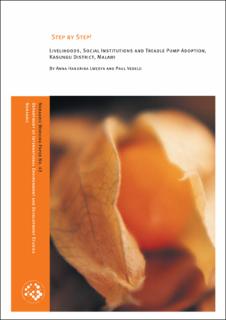| dc.description.abstract | Malawi is among the poorest countries in the world, and looks for ways to increase land productivity in agriculture. In a case study from Kasungu District, Malawi, this study investigates introduction of treadle pumps among poor small-scale farmers and effects of adoption on livelihoods and productivity.
Farmers in the area report an average daily household income of USD 0.84/capita. The Gini coefficient is 0.61, implying a very skewed distribution. Agriculture is more or less the only source of income, apart from some environmental resources, not valued in monetary terms. Major constraints to improved livelihoods relate to lack of land, especially irrigated land, labour and lack of access to reasonable credit. 33% of rural households have adopted treadle pumps in the study area over the last 10 years, in groups (60%) or as single households (40%). Adopting households control more land and labour, they have higher education levels and more access to credit, they are younger, they have higher incomes, especially on-farm and they are more organized, and are generally better off. Treadle pumps will not solve the problems of food security and secure household livelihoods among rural poor dwellers in Malawi but may contribute 15-20 % of incomes to adopting households.
Adoption also reveals a dynamic effect in that adopters increase land under cultivation. They cultivate 5 times more wetland irrigated -land than non-adopters. They also take more crops per year, report 4 times higher yields/ha and can secure production in the critical dry season and other distress periods, improving food security through this “safety net function” of the pump.
Adoption is a process of gradual social change, where skeptical farmers have become convinced through trial and errors that the technology carries merit. A majority of farmers adopt in groups, partly due to relatively high investment costs, but also due to promotion by extension officers. The intervention delivers through an interface in ways compatible with farmers’ lifeworlds. Not without tensions, especially high costs and increased use of labour is a challenge, and there is general skepticism among non-adopters against new technology being alien to their present lifeworld and production system. It seems that using local institutions with their values, norms and social networks enhances adoption rates. The adoption is gradually internalised and becomes part of farmers’ repertoire, as they increasingly report to maintain and repair pumps themselves, crucial in a long term sustainability of the adoption and preventing disadoption. The pronounced group adoption reflects social cohesion in the area and that socio-economic constraints can be overcome through joint efforts. “Step by step” we see that rural households are able to improve livelihoods through this kind of innovation. | en_US |
